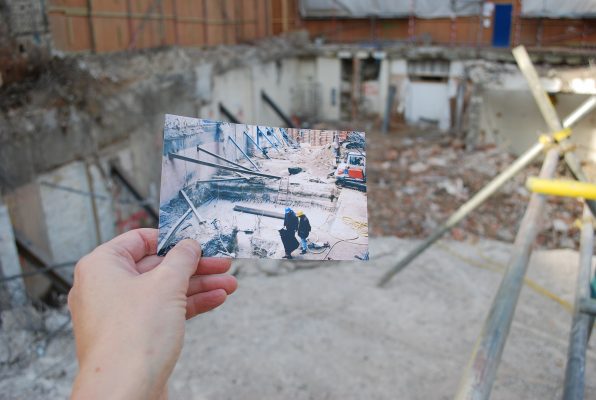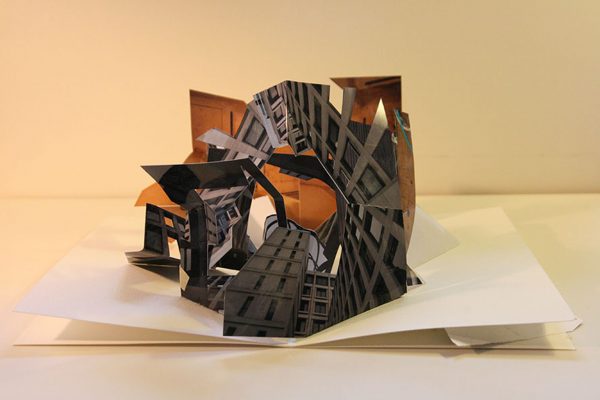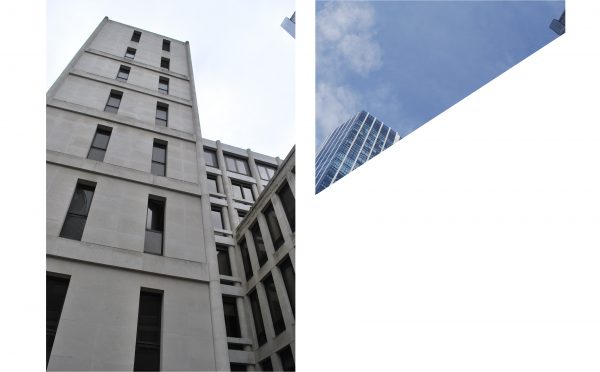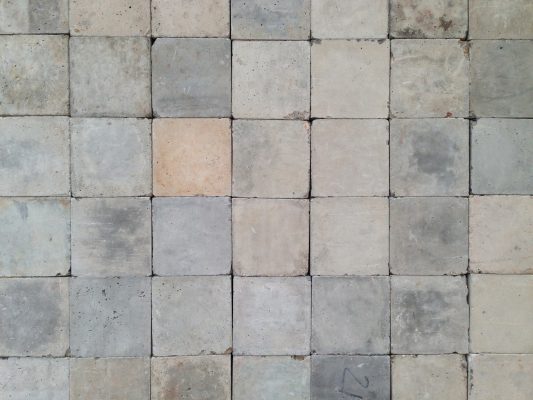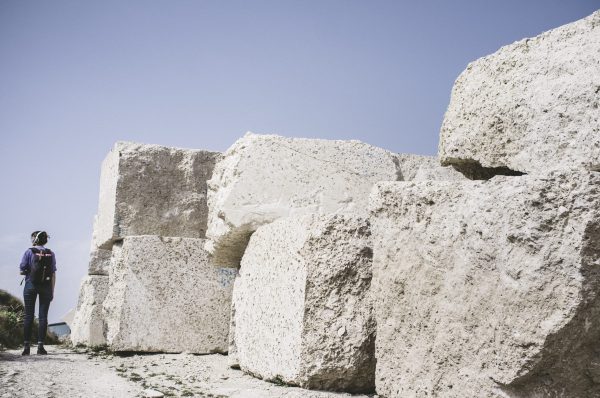Bound with animal fat, milk, or blood, Roman concrete is hardened over time. Less water would ordinarily mean a less workable, yet stronger setting substance – concrete production being a tireless balance between liquid and solid against stability – but sanguine additives introduced bubbles of air, like tiny vehicles for the movement of solid materials through the cement, enabling flow and so multiplying the minutes between the mixing of the concrete and the moment it set for good. A splash of water could be sacrificed without reduced workability. Once the concrete set, each entrained microdwelling of air became a pore, allowing the now solid structure to absorb new water and for this to freeze, thaw, and exit the artificial stone without fracturing its temporary home. In correspondence to the civilisation itself, strength was won and growth quickened with blood.
The first Pantheon was erected following the determining sea-fought battle of that last war of the Republic – the fight that saw Cleopatra exit, like a descendant of so many kings, with an asp to her breast. Its replacement, built under Hadrian – concrete beneath brick – still stands. The resistance of this ancient concrete was forged at scorching temperatures, the ash of Vesuvian eruptions precooked just as the limestone in Portland cement is sintered to clinker today. Two parts volcanic mortar to one part lime; blood for tenacity; horsehair to reduce shrinking; laid by hand in line with its aggregate. It built the Pantheon, the Colosseum, it rebuilt much of Rome and thousands of miles of road. These days a soupier substance is needed to flow through machinery. Watered down by industrialisation, and for the sake of economy, it is required to move faster, to build more. It arrives ready mixed, slow-setting, weaker and bloodless. Its quickflow corpus is reinforced now by steel; cracks begin to appear much earlier on.
As the Empire faded, so too did the common use of concrete, its systematic application being the stuff of large-scale bureaucracy. The Middle Ages had concrete, but not as much, nor as strong, nor so persistent. In building material circles, it stayed off trend until relatively recently and it would be centuries before the role of body fluids in the durability of those ancient structures was recognised. Even then, it was duplicated only by accident; it was noticed that contaminated by the boiled and strained fat of US cattle, when the cement had been milled using tallow as a grinding agent, some concrete roads weathered more trucks than others.
Now Earth endemic, concrete keeps pace with our growth, servile to our colonisation. We’ve grown fond of it and elevated its role from service to decoration, polishing it to a gleam, marking our affection for it with the pawprints of our favoured few. We worshipped it as we enslaved it. Although maybe not entombed six feet beneath the concrete slopes of the Hoover Dam like insects in amber, bodies were certainly sacrificed to the glistening grey material of its making. In this country, Concrete and Construction Engineering lamented in 1921 that ‘the Englishman’s love of the national building material – bricks and mortar – had to be reckoned with.’ Yet the post-war shortage of bricks, of homes, and of builders, eventually necessitated a wider acceptance of concrete. For a while religions excluded it from their churches and temples, or shame-facedly disguised it as sandstone, as was the case with the New Church of Emanuel Swedenborg, built at Crystal Palace in the late nineteenth century. But, eventually came Brutalism, like the French for raw concrete, béton brut, unsweetened rather than savage, and the affair was out in the open.
The toughest breed, Ultra High Performance Concrete, is fabricated where it is at most risk of rapid unprecedented load. Ultra High, in a location prone only to the injuries of pollution, weather and the incessant thud of workers’ feet, spins lightweight structures that pierce the clouds. In a country under attack, it makes for a safe bunker, layered thick, buried deep. Yet concrete’s strength is an illusion that occurs when it is layered up in foundations, pillars, cladded walls. When its unity is displaced through force; in isolation it is exposed as fragile, a brittle substance that suffers violently in an explosion. It can be seen as a horror movie cliché, the one-dimensional character whose insistent masculinity and gym-and-protein-shake muscles cannot protect him from maniacal zombies and so he crumbles in the first few minutes. Yet things are more complicated beneath the surface, for there is no homogeneity in concrete. Its materials have been heated, heaped and provoked into a cohesive mix and they threaten to fly apart in sudden failure just like many things melded under such pressure.
After a car bomb detonated outside the Old Bailey in 1973, one remnant shard of glass – remainder, reminder – stayed embedded in the wall of the main stairs of this croupier to Greater London’s justice. One shard too many this city. Over a decade before Renzo Piano’s began to splinter the sky above London Bridge, a truck exploded outside 80 Bishopsgate in London’s financial sector. Glass shards flung themselves like missiles at its concrete walls; from each of its windows, paper flew like scattered pigeons across the impact zone, secrets, contracts, unprotected data had to be gathered and shredded by scattered pigs; the Blitz-survivor church next door collapsed. As a result of this blast, half a million CCTV cameras were installed to encircle the City, concrete was enlisted to provide accurate pictures of vehicles and their drivers, slowed in their progress by its bulk in plastic-coated blocks. Like the concrete of its dreams, the City absorbed the impact, militarised and hardened. An end to a recession was officiated two days later, the week after that John Major declared it would be ‘business as usual’ for currencies, commodities, stocks and shares, same thing he would say after the 1994 Tel Aviv bus bomb and had previously said when he fired Norman Lamont who had replaced him in his earlier role as Chancellor of the Exchequer. At the time it was common for a building’s insurance to neurotically demand that it be reinstated like-for-like, down to the last decorative details. At the time Amanda Loomes was a civil engineer. In the employ of Wimpey Construction, she and her colleagues painstakingly created a facsimile 80 Bishopsgate from scratch. After the bombed remains were systematically demolished, salvaged components piled up, transported out and reused, with the limited maneuverable space allowed to them in the shadows of neighbouring unexploded structures, the engineers worked to restack the nine storeys. Concrete poured, budgets tightened, camaraderie prevailed and their work was done. So too was Loomes’s work of this kind. Some time later, but not enough, Keltbray Limited demolition company suffered the déjà vu of having to tear down the same building again. Its duplicated nine storeys proved no profitable match to the proposed new buildings which include a forty-storey tower anchored by five contiguous podium floors of 44,000 square foot each, with thirty-two tower floors ranging from 19,000 to 25,000 square foot, to suit any tenant requirement. Loomes had a plant that had been rescued from the desk of a worker at the exploded 80 Bishopsgate. Seventeen years on from its age at emancipation, she returned with it to the demolished 80 Bishopsgate. She couldn’t be sure, but it seemed to shrivel a little.
These days we’re looking for a concrete that can heal its own wounds. A stone infected with the bacteria that on contact with water will wake, germinate, widen and fill the vacuum with calcite plugs. Preemptive tactics for a future laissez-faire approach to maintenance. We’ve run optical glass fibres through concrete to enable it to transmit light, to reveal the bodies behind. What else could we infect this porous material with before we let it set around steel cages? What discovery would it take to have materials engineers play music to their unset concrete just as expectant parents do their unborn children? Concrete, adjectively, denotes the fluid movement of voice from note to note, either up, or down, missing none between. What would an acoustically concrete concrete concrete be? Would buildings lined with sonically enhanced cement possess more resilience in an earthquake? Would they sound better in the wind?
‘Places remember events’, scribbled James Joyce in the margin of his manuscript for Ulysses, perhaps the storage of sound in our architectural materials is how they learn to remember. J.G. Ballard imagined a social undercast, mute and illiterate, who would work in waste removal in such a situation. The eponymous figure of Ballard’s short story ‘The Sound Sweep’ rids interiors of their sonic residue; places of worship are swept free of centuries of coughing and crying, public spaces emptied of the cacophony of fairgrounds and transport links cleaned regularly of the sounds of trains, planes and cars. Extraneous sounds removed from buildings are taken to a sonic dump, leaving the air behind less ‘leaden and tumid’. Unswept, though unheard, it is certain these remaining resonances would tear apart the city. In this world the concrete’s foe is not frost nor blast, its fissures and weakening are the result of police sirens and the echoes of thousands of daily footsteps down a corridor. Like all Ballardian worlds, this one reveals itself as ours when we glimpse it in the rear view mirror or hear about it in the space between radio frequencies: a Western mindset even cursorily examined holds a belief that building materials act as storage for lives lived, sonically or otherwise. The sometimes murder scene and site of burial of most of their victims, their own children amongst these, Fred and Rose West’s home on Cromwell Street was flattened into a footpath rather than reinhabited. Of course there are more (toweringly) pertinent examples, but none that I walked past on school days for five years. Government, on occasion, harnesses this unspoken belief, that buildings and their components can be blamed for other negligences or blunders. ‘Look!’, they say, ‘bad concrete, bleak and brutal, how depressing, it has let everyone down.’ The architects and engineers scratch their heads and wonder at which point they should have informed the concrete it would be responsible for anything other than strength under load.
Data gathered from the British Standards Institution’s concrete test battery neglects, therefore, to recognise some things we expect of the concrete that is used to construct our habitats. Placing it under increasing pressure until it fractures to determine compression strength is the mandate. Small cubes are set from a delivery of wet concrete to a building site, they are placed between the thrust of two plates which slowly, without shock, come together until the cube fails. The load at which it breaks must be at least eighty-five per cent of the strength specified by the grade of concrete for the delivery from which the cube came to be considered ready for use as intended. Concrete cubes are thus routinely and unimaginatively tortured near each and every regulated construction site. The now-artist, Amanda Loomes has said that concrete is sexy. How would we know what grade of sexy a batch of concrete was? Would Norman Foster be more or less likely to buy sexier rated concrete? A concrete number is one that is real, not abstracted for the purposes of theory. One person died in the 1993 explosion at 80 Bishopsgate. Similarly with the qualities of objects or beings, it was a male person who died, concretely, a man. Yet separated from its object, the dead man, that quality, maleness, becomes abstracted. No longer concrete. Hence Pierre Schaeffer’s musique concrète: concrete sounds sampled, recorded, looped and used to compose music. Roman concrete was known as opus caementicium, an opus being now an artistic or literary work or collection of works of magnitude. Yet ‘concrete thinking’ is a psychoanalytic term for a person’s developmental state before they become able to think metaphorically or for when they have regressed from the ability to do so. We seem to have mucked up our etymology and in doing so evicted all other reasonable uses for concrete, word and substance. Just as Bruno Munari’s Supplement to the Italian Dictionary (an anthology of hand gestures that indicate non-verbally when a speaker or their subject is, for example, thirsty, clever, not to blame or a cretin) fills in the gaps of that language’s grammar and vocabulary with the gestures and expressions necessary to its fluid exchange, so too do we need a supplement to the audit of standardised concrete testing. If nothing else, the futility of any such test to provide results of application to human well-being might indicate we are and always have been looking in the wrong place.
